Earlier this month, the United States government launched a new website, healthcare.gov, in support of its recently passed Affordable Care Act.
But things did not go smoothly, and came to a head earlier this week. The site was slow to the point of being unresponsive; it didn't allow users to complete their account registration, blocking them from using the tools and services the site was designed for; and the live chat – one of the most touted features of the new site – was not available.
In fact, the site's problems were so bad that the President spoke out on the issue, even going as far as to comparing the bugs on healthcare.gov to a glitch in iOS 7:
“Consider that just a couple of weeks ago, Apple rolled out a new mobile operating system, and within days, they found a glitch, so they fixed it. I don’t remember anybody suggesting Apple should stop selling iPhones or iPads or threatening to shut down the company if they didn’t. That’s not how we do things in America.”
Some of the issues could have been related to the fact that millions of people were hitting the site at the same time, but for the most part the issues can be blamed on poor planning and even poorer execution.
Even the amount of traffic the site would receive could have been predicted and planned for ahead of time.
But guess what – this type of outcome is far from rare when it comes to large scale IT projects.
This type of failure isthe norm.Consider these stats:
- ¼ of failures on projects with budgets greater than $350,000 were due to "runaway budget costs" (Gartner)
- Only 6.4% of large-scale IT projects between 2003 and 2012 were "successful" (The Standish Group)
- Only 39% of business decision makers believe their internal IT organization has the ability to regularly deliver projects on-time and budget (Forrester)
- 17% of large IT projects "go so badly that they can threaten the very existence of the company" (McKinsey & Company / University of Oxford)
- A typical large IT project is 45% over budget, 7% over time and deliver 56% less value than expected (McKinsey & Company / University of Oxford)
Why Projects Fail
The below chart from a 2012 Gartner report outlines why IT projects fail:

How to Avoid Failure
The simple, one-word answer to this question is: specifications.
At Enginess, the business analysis team creates high-fidelity wireframes and detailed functional specifications and test plans as part of the planning phase of the project, which allows the client team, designers and developers to all share a vision for the outcome of the project before a line of code is written.
Beyond that, it's a matter of controlling the timeline and scope of the project with a thorough and attentive project management team.
Of course, the larger the project, the more difficult it is to spec and control scope, but at the core of IT projects, these are the make-or-break issues.
What the Government is doing to fix healthcare.gov
Recognizing that they missed the mark on their new website launch, the U.S. government is now promising to throw more resources at the problem in order to clean up the mess:
Our team is bringing in some of the best and brightest from both inside and outside government to scrub in with the team and help improve HealthCare.gov. We're also putting in place tools and processes to aggressively monitor and identify parts of HealthCare.gov where individuals are encountering errors or having difficulty using the site, so we can prioritize and fix them. We are also defining new test processes to prevent new issues from cropping up as we improve the overall service and deploying fixes to the site during off-peak hours on a regular basis.
Some could say that these teams and processes should have been in place at the outset of the project, especially for a project with a high profile such as healthcare.gov.
But as it's been stated before, these types of failures are so common on large-scale IT projects that it would have been a safe bet to predict the issues that occurred on the project before they even happened.
The good news is, thanks to the lessons learned from healthcare.gov's mistakes, your next project doesn't have to suffer the same fate.
